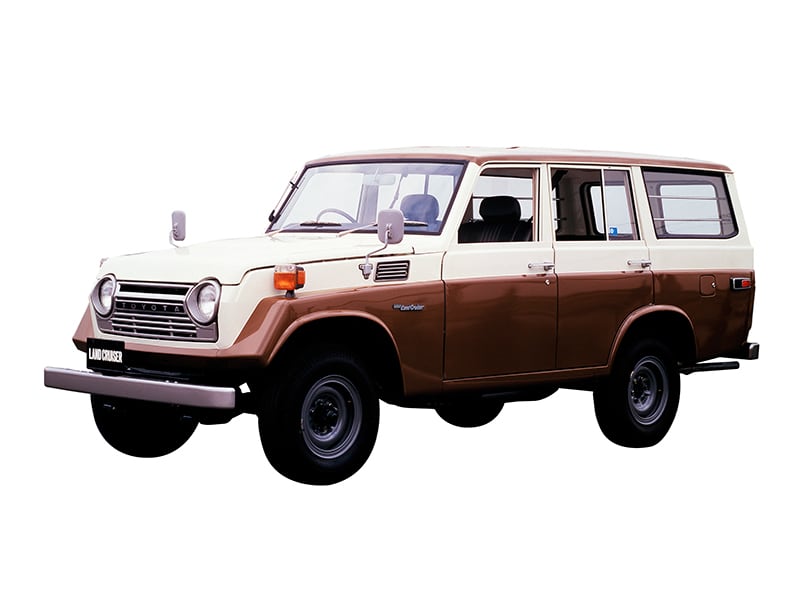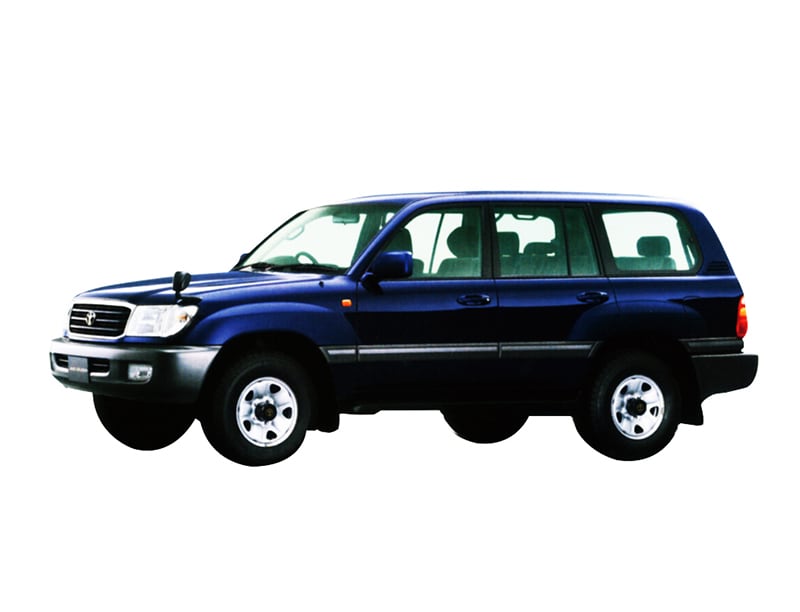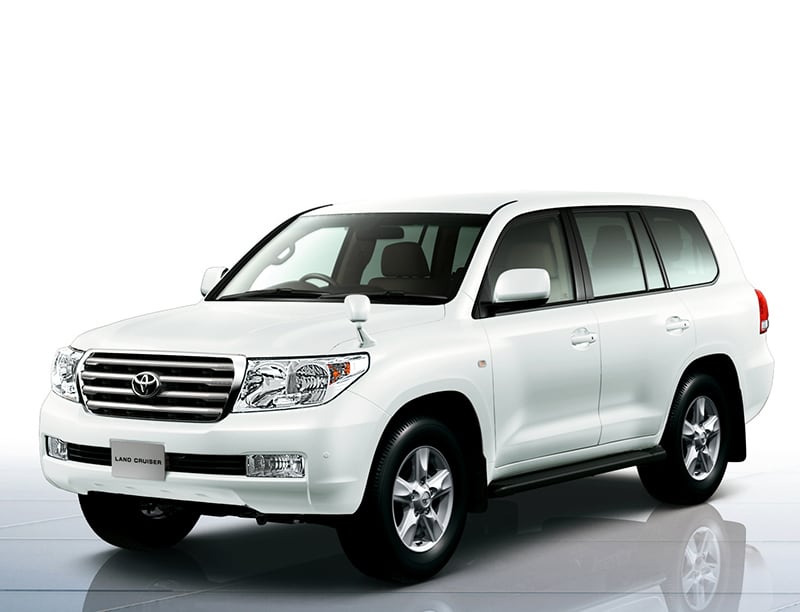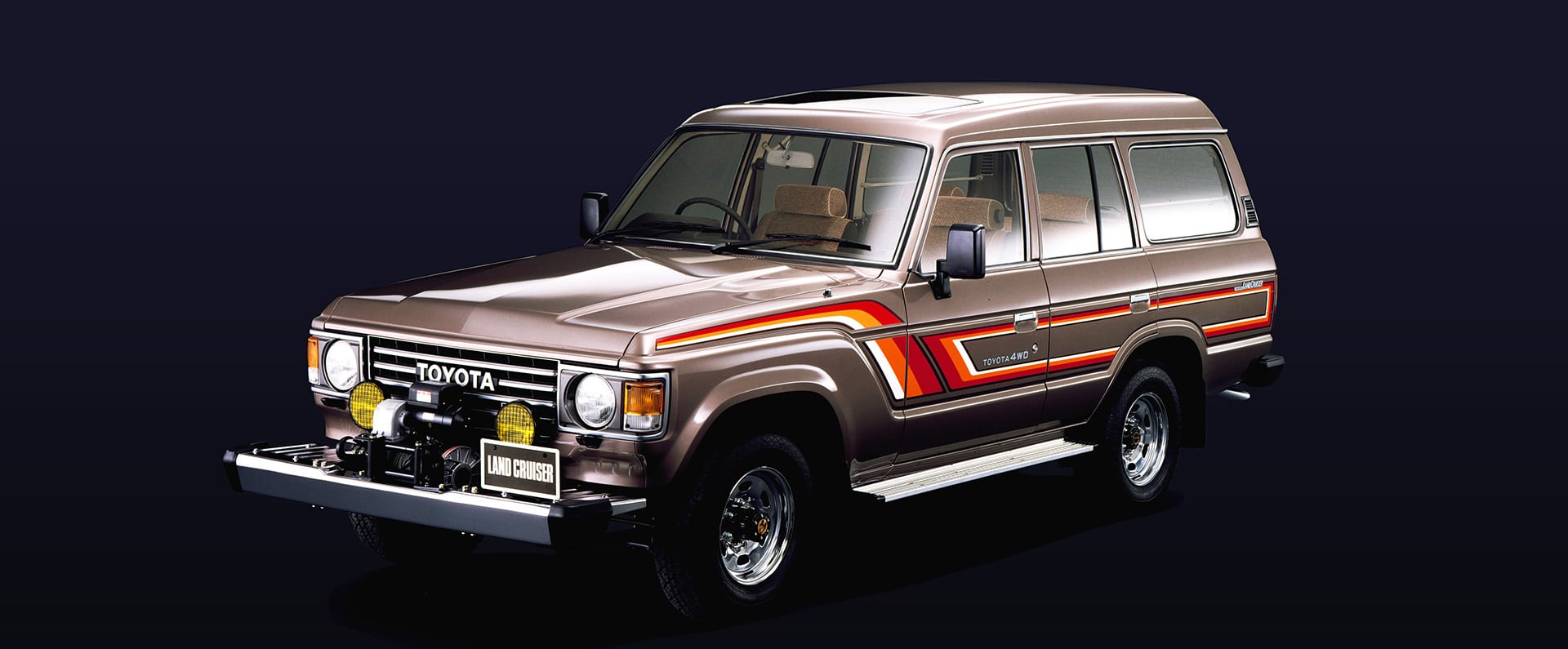1967
Land Cruiser 50 series

The Land Cruiser FJ55 station wagon was introduced in August 1967, featuring a 2,700 mm wheelbase chassis and a newly designed body, and replacing the FJ45V 4-door van with a wheelbase of 2,650 mm. Although the FJ55 was classified as a van (commercial-use vehicle) in Japan, it was positioned as a passenger vehicle in overseas markets where it was principally sold.
The back door was either a bottom-hinged gate (which could be pulled open when its glass window was rolled down) or out-swinging double doors. The power train consisted of a 3.9-liter 6-cylinder gasoline engine (Type F) that developed 125 hp (boosted to 130 hp in 1969), a 2-speed transfer case, and a 3-speed manual transmission. To comply with the emission standards, the FJ55 for the domestic market was replaced with the FJ56V in January 1975, adopting an inline 6-cylinder 4,230 cc 135 hp engine (2F) and a 4-speed manual transmission.
1980
Land Cruiser 60 series

The 60 Series was released in August 1980 as the successor to the 55 Series. While the export model was a station wagon, the domestic model was classified as a van (commercial-use vehicle). The external appearance was substantially renewed. The gasoline engine was upgraded to a 4.2-liter unit (2F), and a 3.4-liter diesel engine was also introduced. The front bench seating was replaced with separate seats to better support the driver's posture, thereby reducing the passenger capacity from six to five. Availability of air conditioning, power steering, and fabric seats also appealed to a wide range of individual users.
Two years later, a 6-cylinder 3,980 cc diesel engine (2H) was made available. Models with high-powered engines with turbocharger and EFI were also introduced later in the model life, along with such devices as automatic transmission and diff lock systems.
1989
Land Cruiser 80 series

This model succeeded the 60 Series in October 1989, adding an 8-seater station wagon to the lineup. To enhance the product's competitiveness in the overseas markets including North America and Australia, its body length and width were increased to 4,970 mm and 1,930 mm, respectively, while the styling, specifications, and equipment were upgraded to the level of a luxury sport utility vehicle (SUV).
The wagon initially came with an inline 6-cylinder gasoline engine, while the van was fitted with a newly developed inline 6-cylinder 4.1-liter diesel engine (naturally aspirated or turbocharged). The leaf springs of the rigid axle suspension were replaced with coil springs to offer improved ride comfort, and higher-end models also adopted a full-time 4-wheel-drive system with a center differential. In August 1992, the gasoline engine was replaced with a 4.5-liter inline 6-cylinder 24-valve unit producing 215 PS. The vehicle's luxury SUV concept, as well as its superior performance and robustness under harsh natural conditions, won high admiration all around the world.
1998
Land Cruiser 100 series

The Land Cruiser 100 was released in January 1998 as the successor to the Land Cruiser 80. The 100 improved its basic 4-wheel-drive (4WD) performance and enhanced its prestigious image as a luxury 4WD vehicle. The 5-door wagon body retained the separate frame structure, while the body dimensions were expanded to increase the cabin size.
The engine was a 4,663 cc 235 PS V8 DOHC 32-valve gasoline unit (2UZ-FE) that was newly developed for the wagon model, with which a 4-speed automatic ECT-i transmission was combined (to be replaced with a 5-speed automatic in August 2002). The drivetrain employed a full-time 4WD configuration with a sub transmission. The van model came with a 4.2-liter L6 24-valve direct injection EFI turbo diesel unit (1HD-FTE).
The rigid axle front suspension used on the preceding Land Cruiser 80 was replaced with an independent double wishbone and torsion bar spring system. The top-end VX Limited model offered an optional new device that combined Active Height Control (AHC) with the Skyhook TEMS. The rack and pinion steering was newly adopted, and both front and rear brakes employed ventilated discs with hydraulic booster.
In December 1998, the top-grade model Cygnus was released.
2007
Land Cruiser 200 series

The Land Cruiser 200 Series was launched in September 2007 as the successor to the 100 Series, expanding the length and width by 60 mm and 30 mm, respectively. Adopting a redesigned separate frame structure, the new Land Cruiser featured enhanced rigidity, durability, collision safety, and interior comfort.
The 4.7-liter 2UZ-FE V8 gasoline engine featured the intake VVT-i system, increasing the output by 39 kW (53 PS). The world's first "crawl control" feature was standard-equipped to automatically maintain a very low speed when driving on surfaces such as rocks or sand and on steep hills. A newly developed Torsen LSD transfer unit also came standard on all models, which could instantly change drive power distribution to match road conditions to deliver smooth and stable driving performance. The 200 Series was marketed in more than 100 countries as a high-end sport utility vehicle (SUV). In the North American market, the vehicle was fitted with a 5.7-liter gasoline engine and was offered as the third-generation Lexus LX, the top-of-the-line SUV model for the brand.


